40 Unusual Animals We Probably Won’t Find On Our Next Hike
The world around us is filled with a diverse range of wildlife. All of which vary not only in stature but also in demeanor, appearance, and habitation. Many of the world’s more wonderous animals are made known to us thanks to nature programs, documentaries, and magazine articles. All thanks to the effort of the conservationists and environmentalists who have dedicated their lives to preserving this world’s wildlife.
However, while many amazing species have been shown to us time and time again, many of them tend to outshine some lesser-known species. This article will fix this by showcasing some species of animals that you likely have not heard of before. Many of the animals you will see today were kindly collected by the Twitter user, Weird Animals. Keep reading to learn about some of these unique and lesser-known creatures.
The Sea Bunny Mollusc
Kicking things off, we have this cute little fellow to show you. This snowy white little creature is a species of sea mollusk, endearingly referred to as sea bunnies. While it was first spotted in Japan, it has since been found elsewhere.
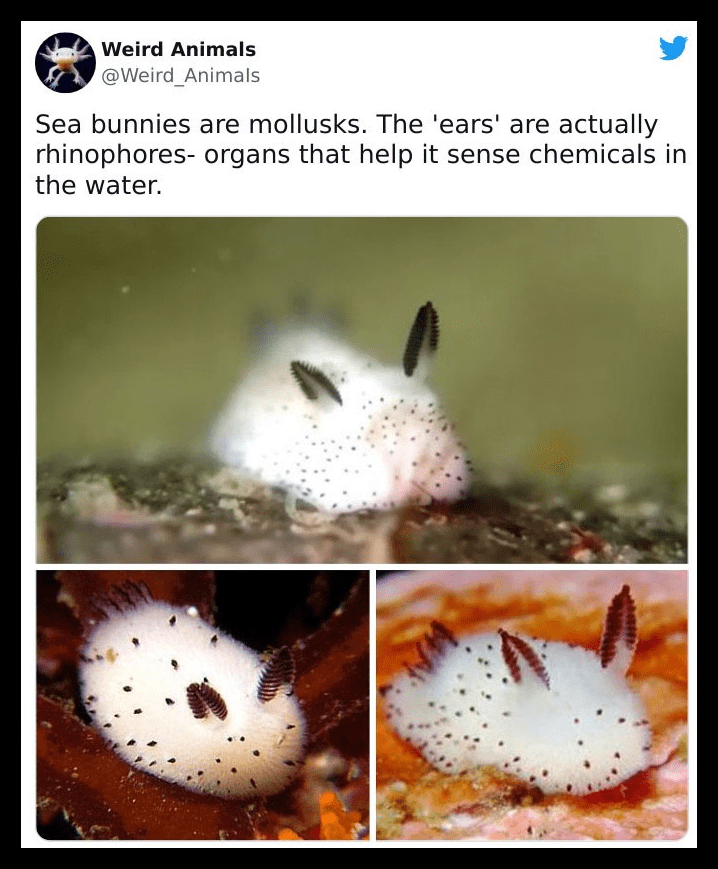
Jorunna Parva, as it is officially called, was called a sea bunny due to its white coloration and pointy ears. These “ears” are actually called rhinophores, a sensory organ that basically serves as scent and taste, and probably auditory, receptors.
Bobtail Squid
While some species evolved to have more subtle colors, others went for the complete opposite. A fine example is this stunningly opalescent and glittering bobtail squid. We wonder if it has ever been mistaken for an underwater rainbow by deep-sea explorers.
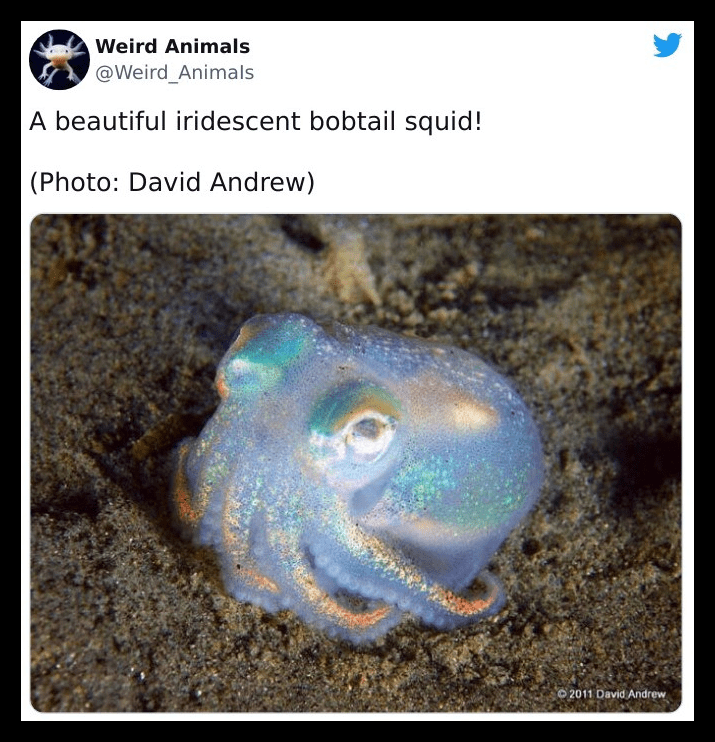
What is particularly interesting about its iridescent sheen is that it’s actually the result of bacteria. Yep, the bobtail has a symbiotic (mutually beneficial) relationship with a type of bioluminescent bacteria that creates these shining pigments. The pigment that actually works as camouflage.
The Arctic Fox Changing Coats
Most of us have likely heard that animals, such as our dogs, have winter and summer coats. Not coats like the ones you wear, but their actual fur coats. With most animals, there is no real visual difference between them.
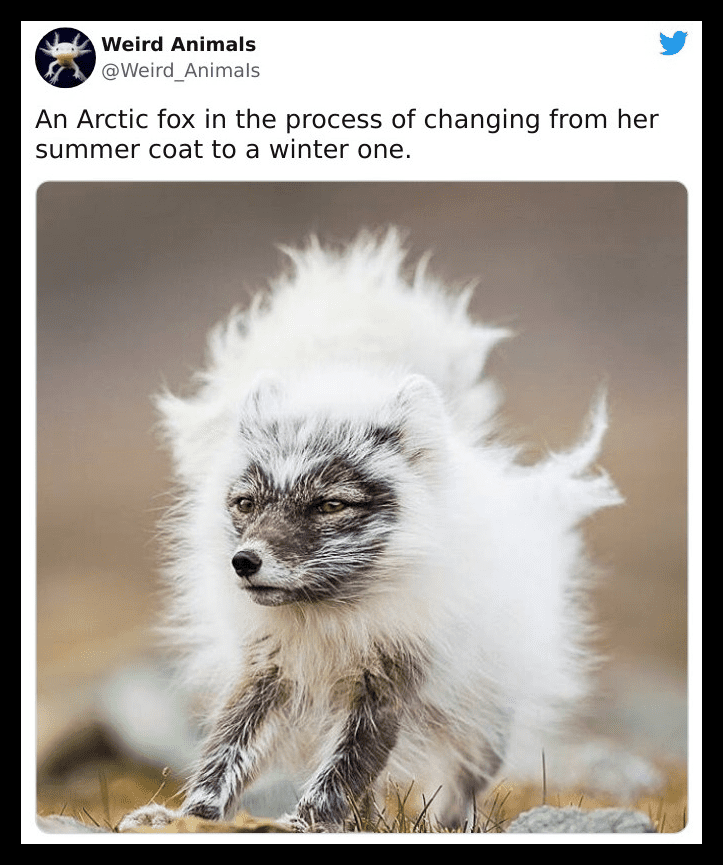
However, there are also a lot of animals that do have definite visual differences. Like the Arctic fox, which has an ordinary grey coat, and a stunning snow-white winter coat. Their winter coat has the added benefit of acting as camouflage.
The Malabar Giant Squirrel
Other animals have a very different conceptualization of camouflage. In this case, we are talking about the Malabar/Indian giant squirrel, a species only found in India. The Malabar squirrel is known for its multi-colored fur that includes whites, reds, and browns…
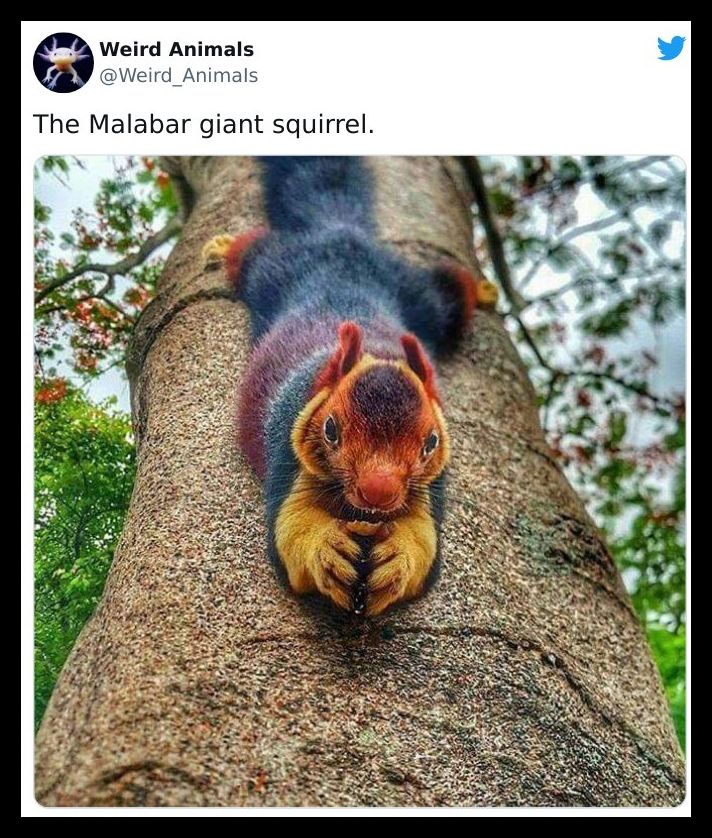
…a mix of colors that are on full display in this stunning picture of the squirrel enjoying a nice snack. The Malabar make their homes in the very heights of the treetops, where their thin, nimble 11-meter bodies zip around.
A Rare White-tailed Deer
Every now and then, really interesting animals come about as a result of genetic abnormalities. A great example is Dragon, a white-tailed deer with an angelic, white-furred face. Its distinctive white face was actually the result of a genetic defect.
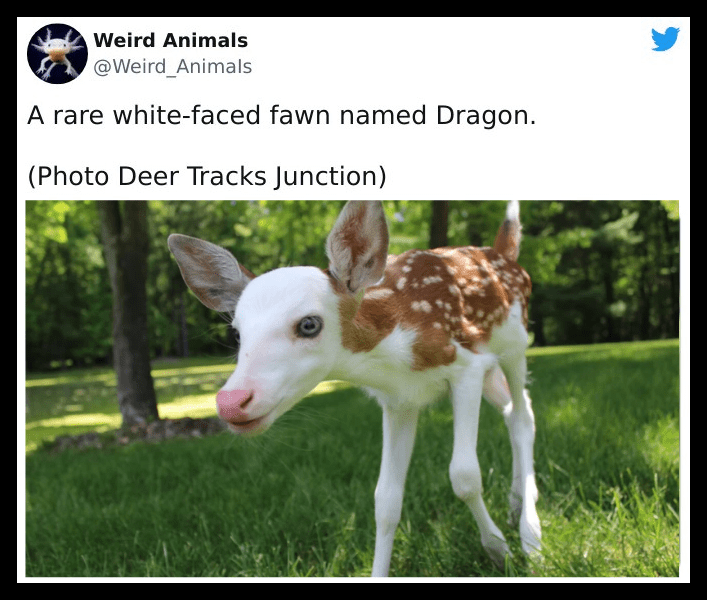
Little Dragon is a Piebald deer, a type of deer whose name refers to having a great amount of white fur. The white face sadly led to Dragon’s mother abandoning him. Fortunately, he lived a loved life at a deer sanctuary.
Honduran White Bats
Bats often get a bit of unfair treatment due to them looking a little creepy. Not to mention all the associations people make with them and vampires. That said, we think we know a species of bat that is sure to impress everyone…
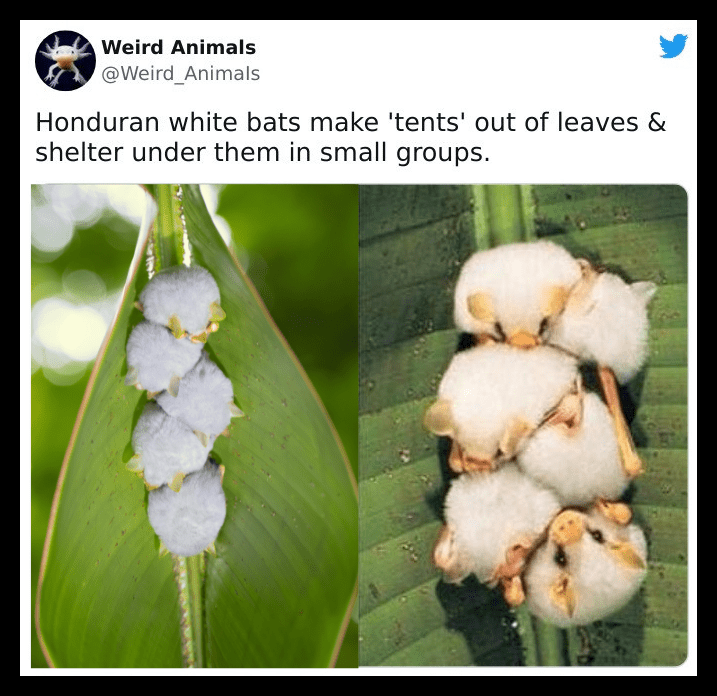
Introducing the Honduran white bat, also called the Caribbean white tent-making bat. This bat can be found from Honduras to Costa Rica to parts of Panama. They are called “tent-making” bats due to them sleeping and sheltering in the leaves of trees.
Glowworm Beetles
Speaking of creatures that are not always looked on kindly, let’s take a look at some rather peculiar-looking insects. Kicking things off, we have this funny-looking critter known as a glowworm beetle, part of the family Phengodidae. There are many interesting species, but let’s look at one in particular.
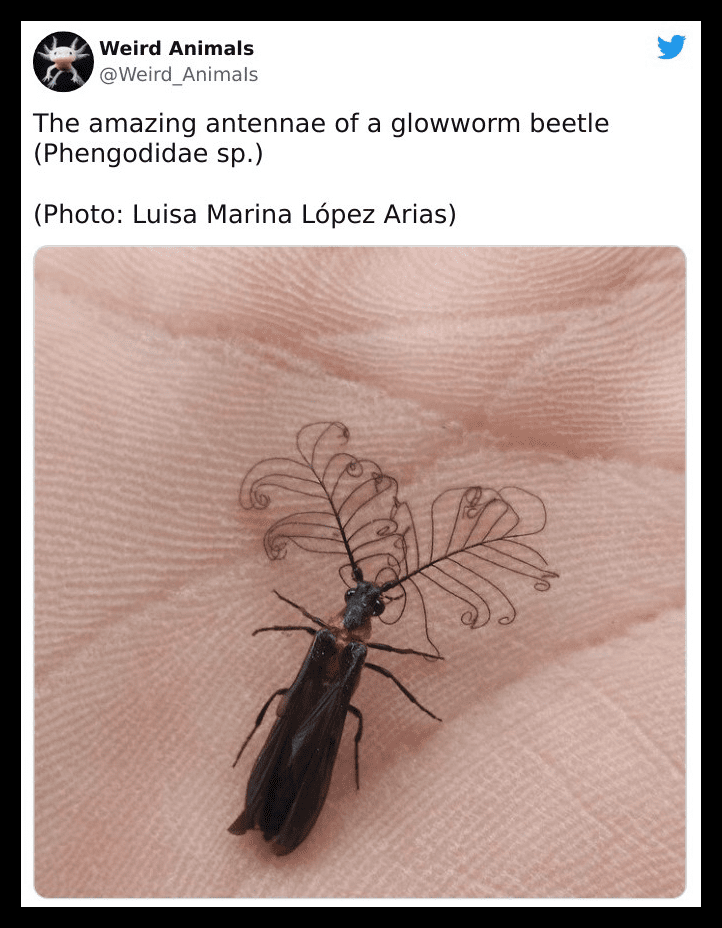
As you can gather from its name, the glowworm beetle has bioluminescent organs that let them glow in the dark. Another interesting detail about these beetles is their fanciful little head antennae. There is just something so magical about them!
Indian Flower Mantis
This dazzling fellow is a Creobroter pictipennis, more commonly known as the Indian flower mantis. This beautiful mantis is native to parts of Asia where it makes its home among flowers. The greenery is something that its fanciful and colored wings capture and mimic.
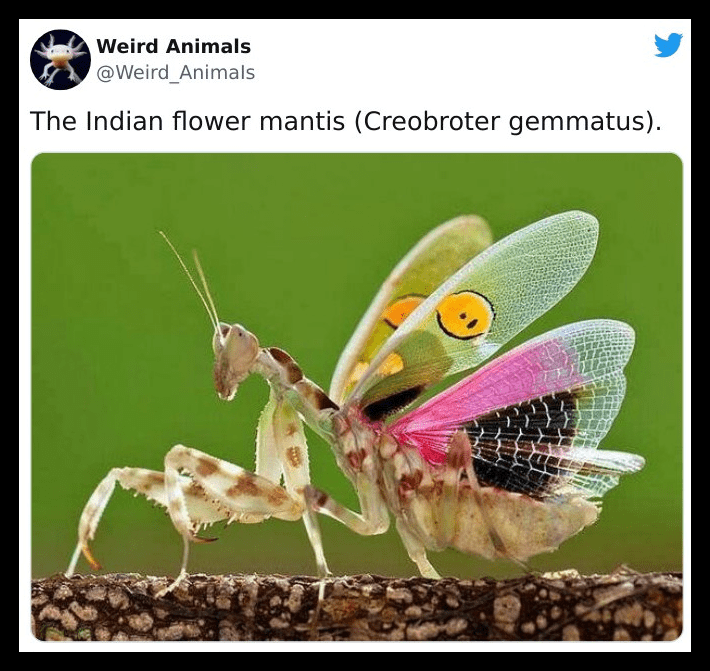
The flower mantis grows to around 4 cm in length, with the females of the species tending to be larger, as is true in many speices. They also don’t live for very long, only reaching a maximum age of 9 months when living in captivity.
Emerald Cicada
Found among Neotropical and equatorial regions lives the Zammara cicada, a genus more commonly referred to as the emerald cicada. They are known by this name thanks to the brilliant shades of blue-greens that color their skins and outer shells.
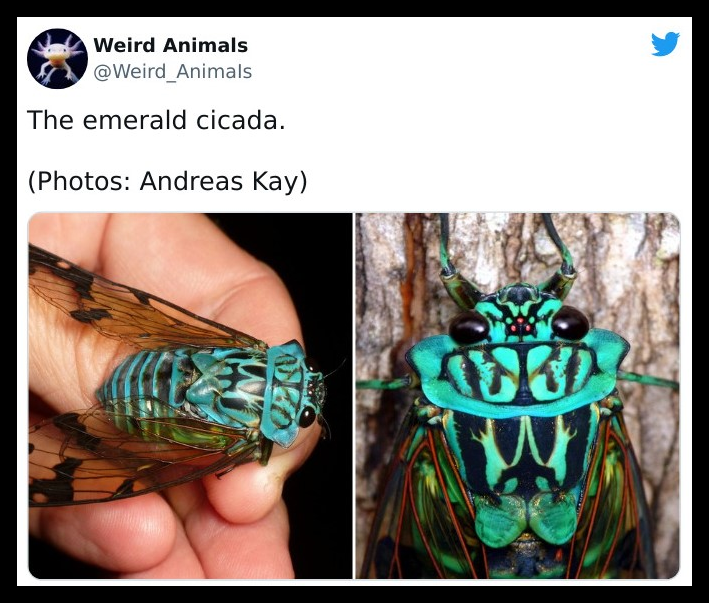
Though the name can make things a little confusing, seeing as there are 16 species within the genus. Like other cicadas, they can also be quite noisy. The Zammara is known for the distinctive pulsating buzzing sound that they make with their iridescent wings.
The Nightmare Caterpillar of the Citheronia Moth
Many species of butterflies and moths are known for their artful and colorful wings. The Citheronia regalis, colloquially called the royal moth, is known for its range of bronze and deep brown reds with flakes of white that decorate them.
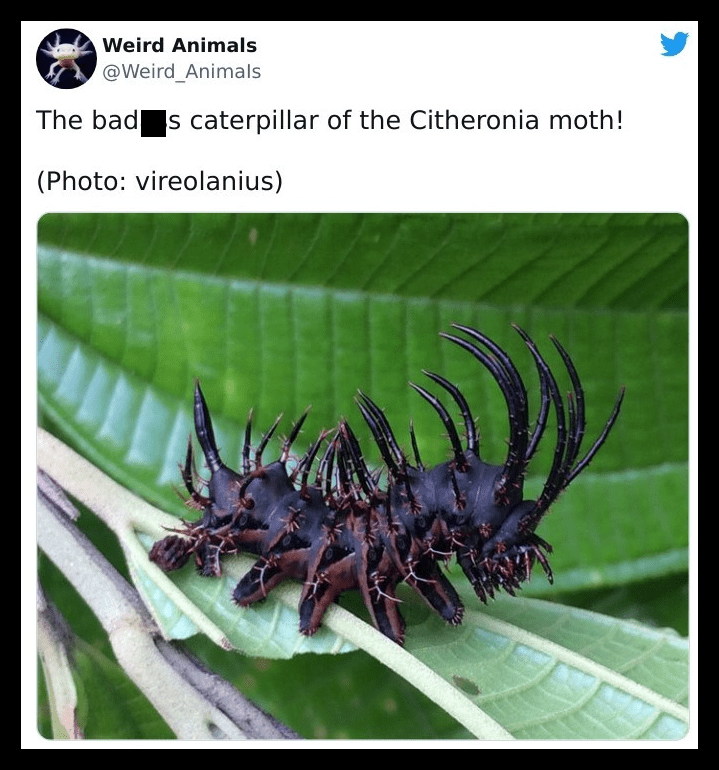
While the royal moth is beautiful when fully grown, it is nightmarish as a caterpillar. Or perhaps terrifying is a better word to describe these barbed and spiked worms. At least it is only scary for a short period of time.
The Great Nawab Caterpillar
The great nawab, known as Polyura eudamippus, is another delightful butterfly that is native to India. Unlike the nightmarish caterpillar form of the royal moth, the nawab’s caterpillar form is quite stunning. They have an appearance that makes them seem almost alien.
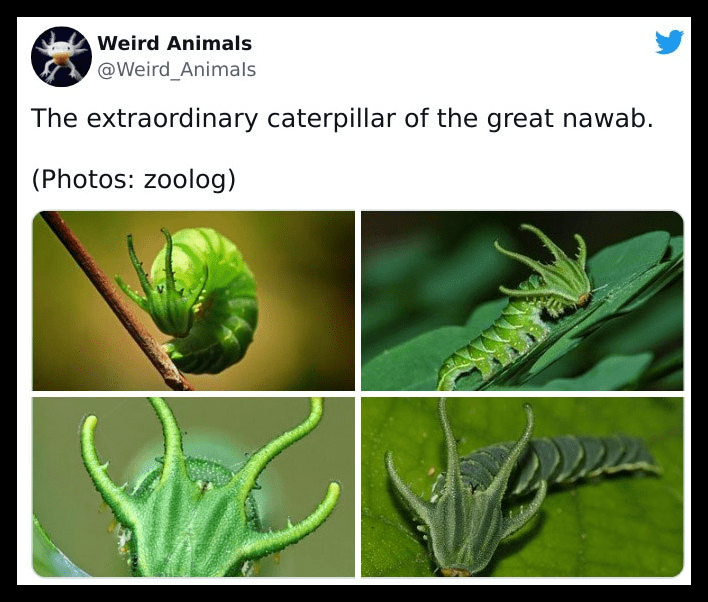
That’s something you can hopefully also see by the four prongs that sprout from their head crests. Unlike our previous spikey friend, these seem to form a dainty headpiece. If anything, it is kind of magical-looking, in a strange way.
Ayam Cemani Chicken
Let’s take a break from our insectoid little friends for a bit. But don’t worry, we have something even more weird-looking for you to check out. Introducing the rare Ayam Cemani chicken from Indonesia. This species has a unique and interesting detail about it…
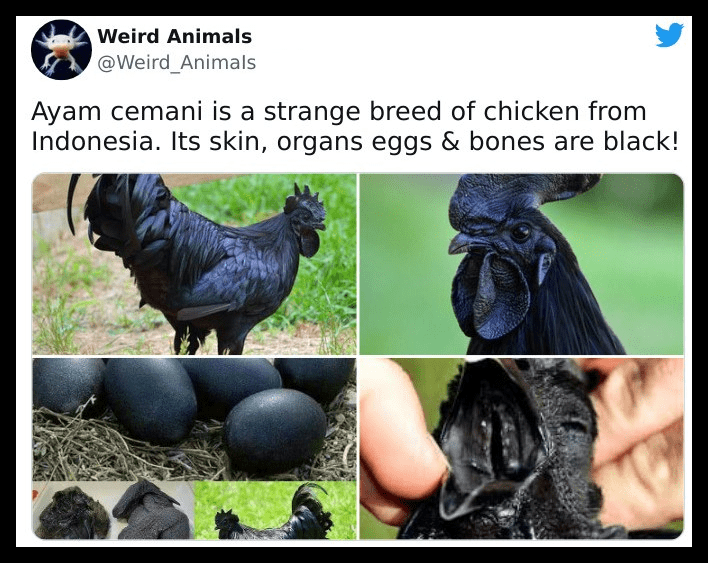
The entire body of the Ayam Cemani chicken, including its organs, is pitch black. Not only that, but the eggs are fully black as well. This fascinating coloration is due to the breed having hyperpigmentation which causes the black coloration.
The Mountain Bluebird
If you think about it, the majority of the most colorful animals happen to be birds. Even the black chicken is uniquely colored. Up next, we have the delightful mountain bluebird who makes it home in the western parts of North America.
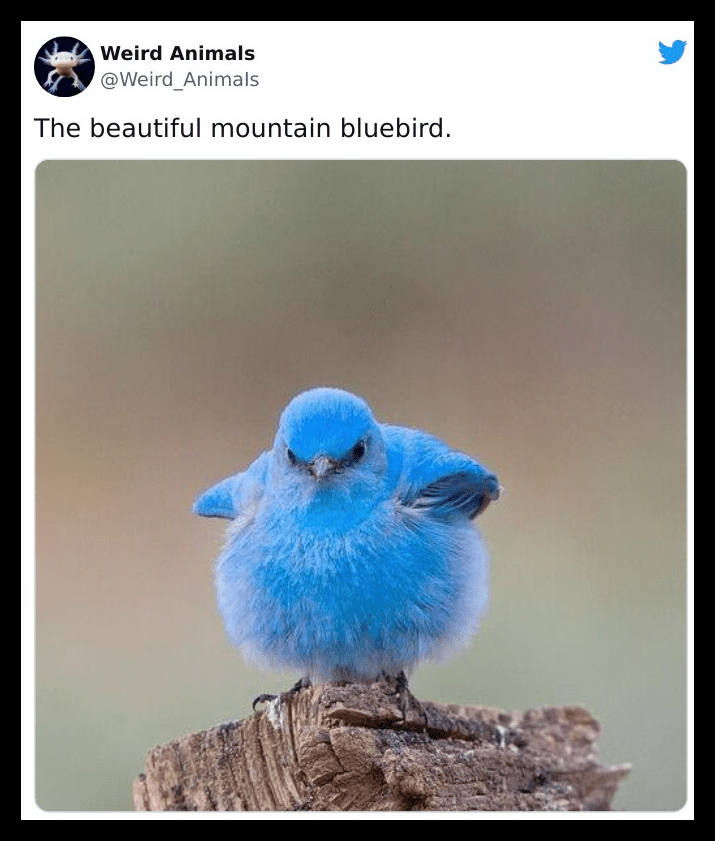
Contrary to what their name might imply, only the males of the species actually have blue plumage. The females of the species still have a bit of blue or turquoise plumage scattered here and there, but they tend to be more gray than blue.
Pink-Necked Green Pigeon
Speaking of colorful birds, if you thought the bluebird was a stunning creature, wait until you see the pink-necked green pigeon. This species of bird can be found in Vietnam, Myanmar, and other parts of Southeast Asia and its various islands.
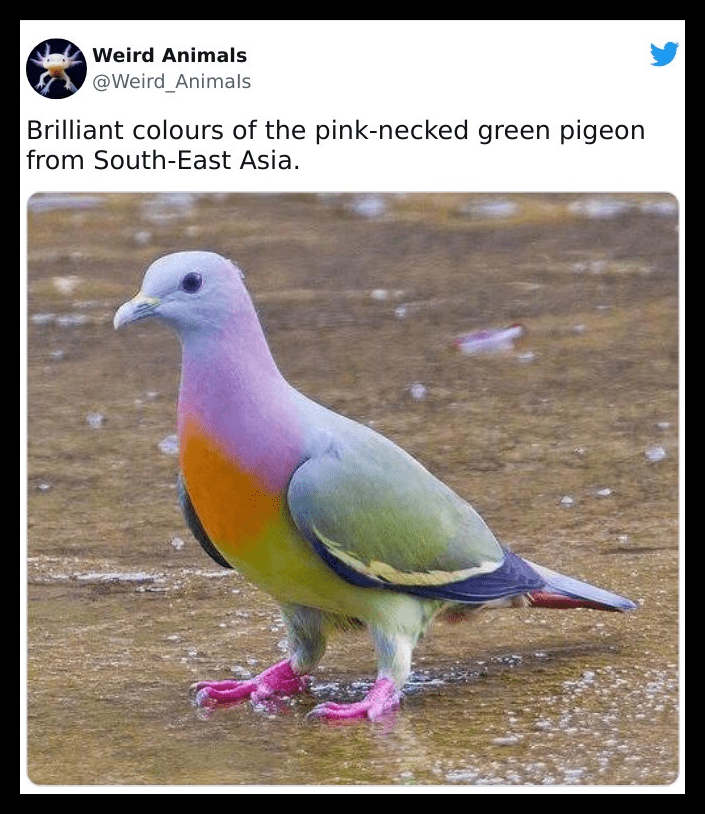
Just like the bluebird, there is a difference in coloration between the genders. The females, for instance, are almost entirely green, whereas only the males have the famous pink plumage for which they are named. Regardless, they’re both beautiful to look at.
Duckbill Tree Frog
Reptiles, amphibians, and lizards are a really cute bunch of animals. More often than not, the larger or longer they are, the scarier and more unsettling they are. The smaller and rounder they are, the cuter and more adorable they become.
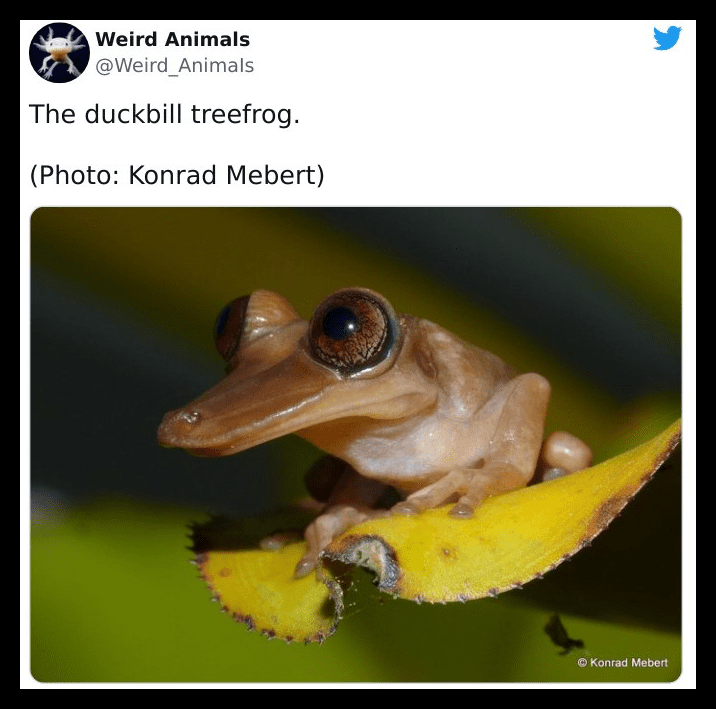
A great example is the duckbill tree frog, an appropriately named frog species that is part of the genus Nyctimantic. These cute little guys are found in the Orinoco Basin which lies within the borders of Brazil, Colombia, and Venezuela.
The Mission Golden-eyed Tree Frog
While we are looking at tree frogs, have you ever heard of the adorable Mission golden-eyed tree frog? Yes, it’s a really elaborate name. It that describes the small parts of golden-yellow that surround its eyes. But that isn’t its only distinguishing feature.
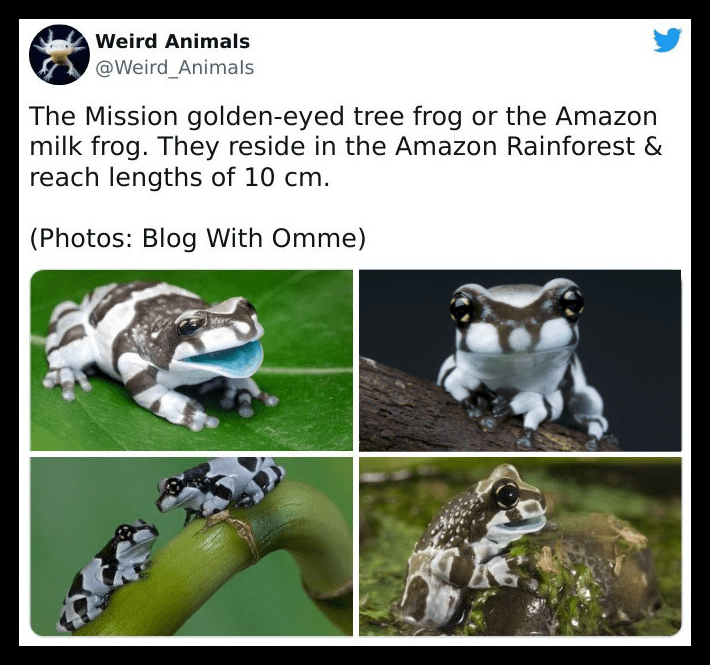
It is also known for its white pattered body as well as its mesmerizing blue mouth. It’s for these features that it is also called a blue milk frog and the Amazon milk frog. They can be found living along Brazil’s Maracanã River.
The Orange Tortoise Spider
Ask anyone what they think about spiders and chances are high that most of them will find them unnerving — a response that is understanding based on how most of them look. That said, not all spiders are actually that creepy.
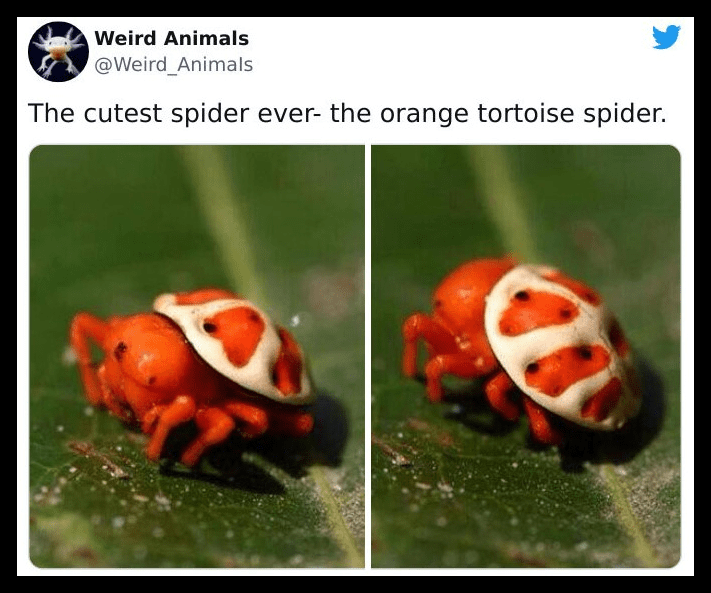
Introducing the orange tortoise spider, officially known as Encyosaccus sexmaculatus. The orange spider is from South America and is part of the orb-weaver genus. The near entirety of their bodies is orange or a shade of glossy red with a white back.
Mary River Turtle
No, you are not looking at a turtle swimming underneath a floating piece of grass. What you are actually looking at, is the turtle’s shell which is completely covered with grassy algae. That’s one way to camouflage yourself from predators!
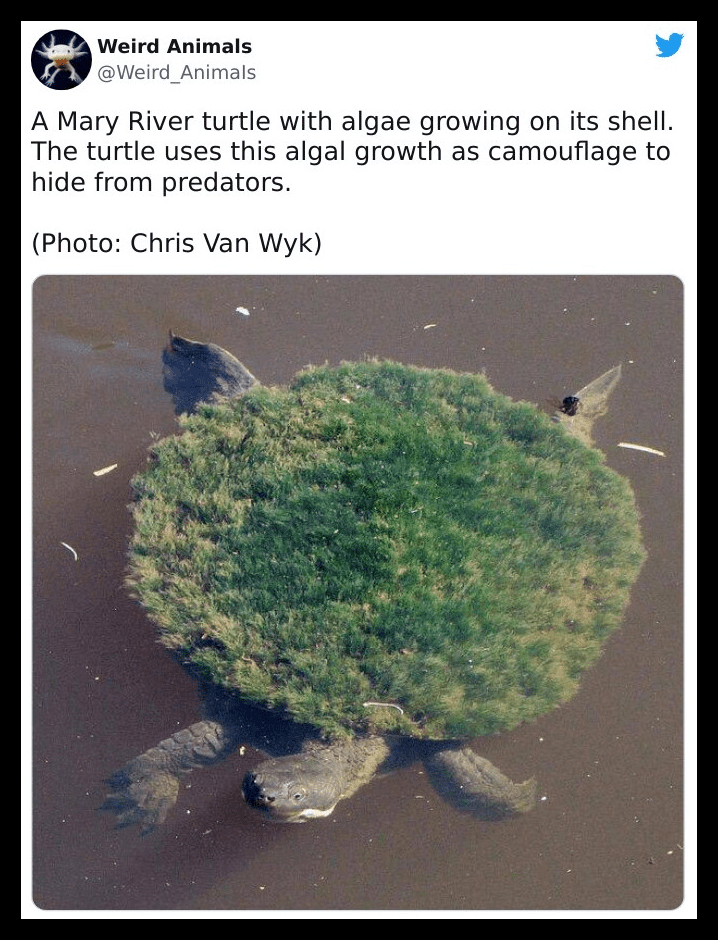
This is a Mary River Turtle that lives around the south-eastern waters of Queensland, Australia. The turtle gets its name from the Mary River which runs through the region. Sadly, it is endangered due to low reproduction rates and loss of nesting areas.
Marine Iguana
When it comes to rare species of animals, no place on Earth has the Galapagos islands beat. The archipelago broke away from larger land masses millions of years ago; an event that allowed the animals living on it to evolve in interesting ways.
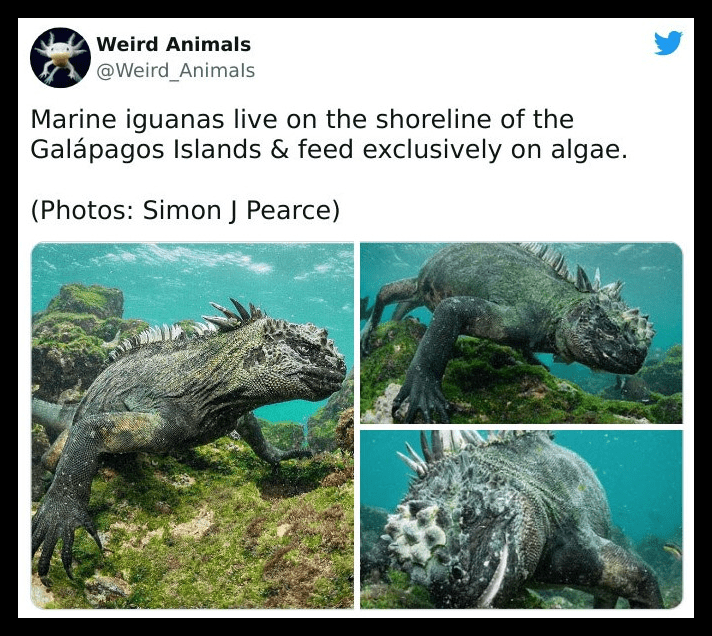
A great example of one such species is the iconic marine iguana, which can only be found there. What makes them especially interesting is the fact that their diet is primarily comprised of sea algae. Another modern living dinosaur. Don’t you think?
The Viper Dogfish
The animal we are going to show you is not the most charming or cuddly-looking animal. In fact, it is borderline terrifying and rather nightmare-inducing to look at. What we are talking about is the deep-sea and razor-toothed viper dogfish.
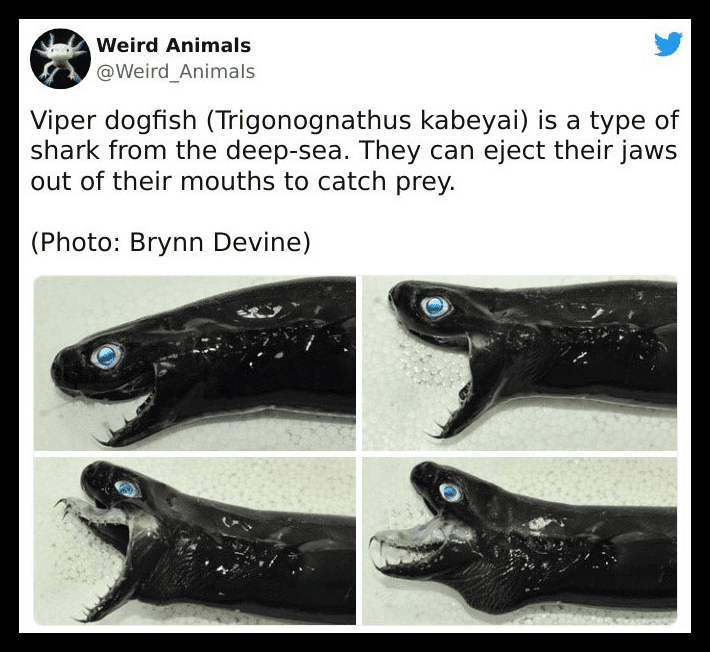
The viper dogfish is part of a species of called dogfish sharks. Yep, these 50 cm long eel-like creatures are actually related to proper sharks, like the great white. Something which isn’t too hard to believe once you have seen their jaws.
The Valais Blacknose
When someone mentions a sheep, you likely have a very clear picture of one in your mind. The only issue is that not all sheep look the same. A fine example would be the Valais Blacknose sheep from the Valais region of Switzerland.
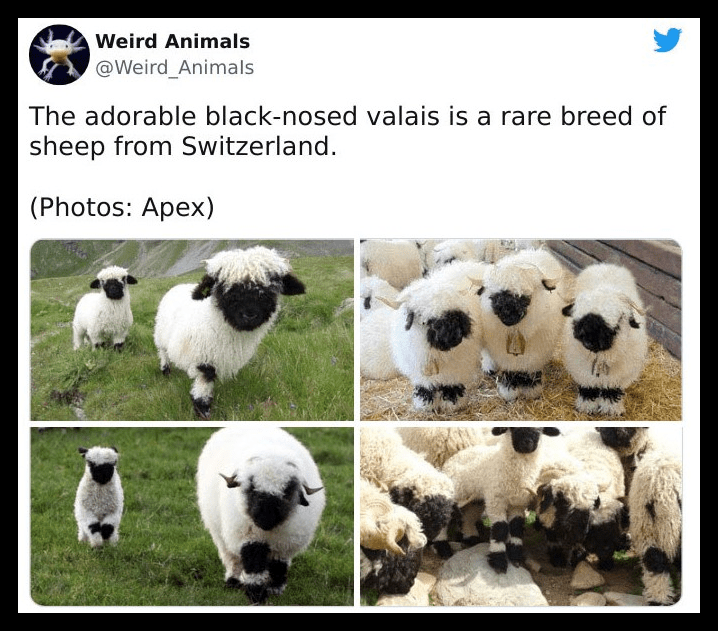
For those of you from the region, you likely know it better from its German name, Walliser Schwarznasenschaf. These sheep get their name from their black muzzles. The Valais is known as a dual-purpose sheep that is bred for both wool and meat.
Asian Giant Softshell Turtle
Speaking of animals with unique features that give them their name, have you heard of the giant softshell turtle? The turtle gets its name for the smooth and fleshy appearance of its shell. In fact, you could not even call it a shell.
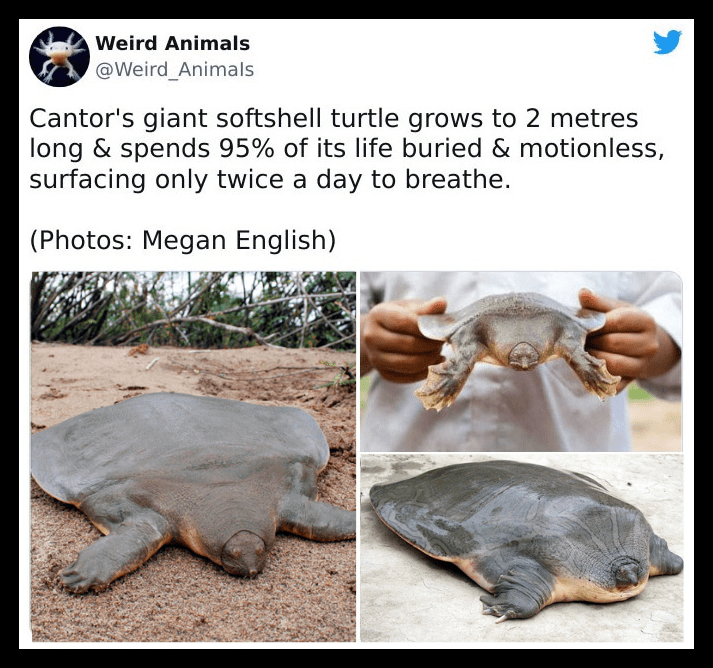
This turtle has been reported to live for over a hundred years. However, when it comes to how big they can grow, that has been harder to determine. Most species have been recorded to reach 130 cm and weigh over 100 kg.
Purple-Crowned Fairywren
Sometimes, something may appear to be ordinary looking from a glance, but actually has more to it than meets the eye. A fine example is the purple-crowned fairy wren, a bird that looks like any other, except for two colorfully striking features.
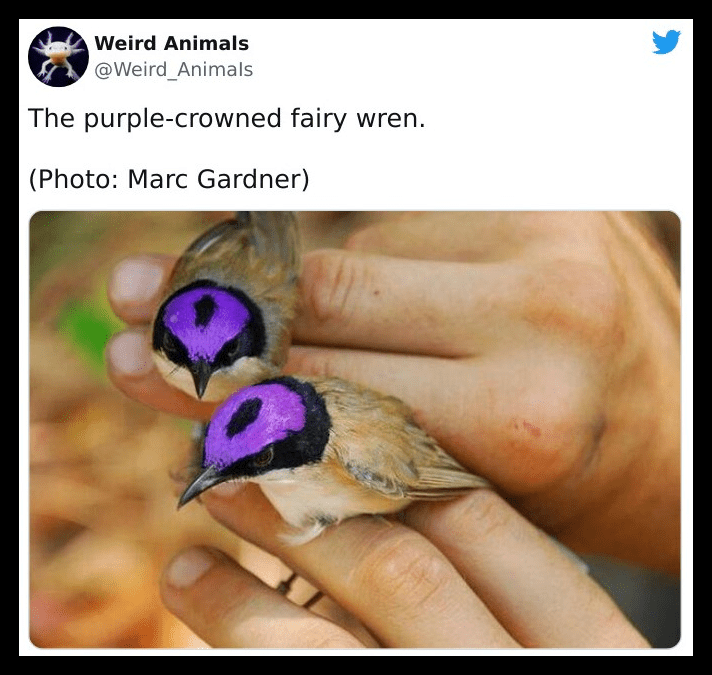
The first is its lovely purple plumage that covers the crown of its head. And the second is the shiny blue plumage of their tail feathers. The purple fairy wren lives in small parts of Australia and New Guinea to the north.
The Silky Anteater
Get ready for a cuteness overload once you see the next animal. These adorable little bundles of fluff are called silky anteaters. The silky anteater is native to parts of Central and South America and is the tiniest of the anteater species.
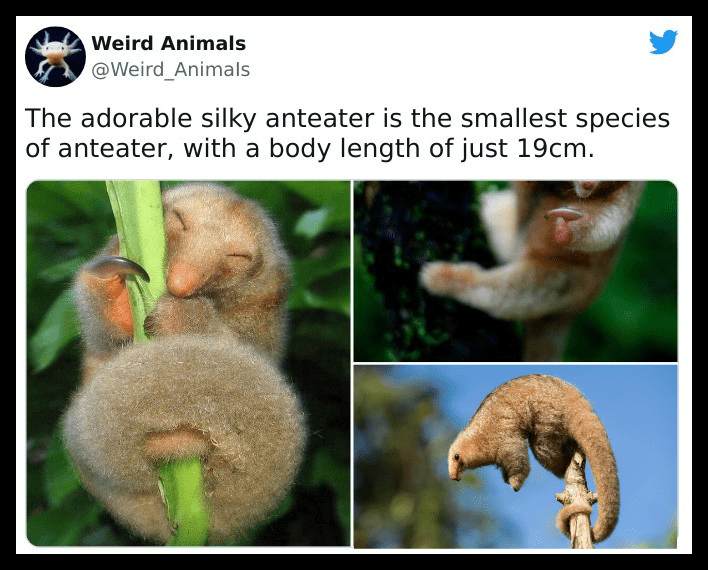
The silky anteater only reaches a length of 36-45 cm and weighs far less than half a kg when grown. The colors of their furs can range from simple yellowish browns to greys or even coats with a silvery sheen.
The Melanistic Serval
When we think of species of wild cats, our minds tend to first gravitate towards the famous big cats. But there are actually plenty of smaller species of wild cats as well. This one is called a serval, though the one in the picture is quite special.
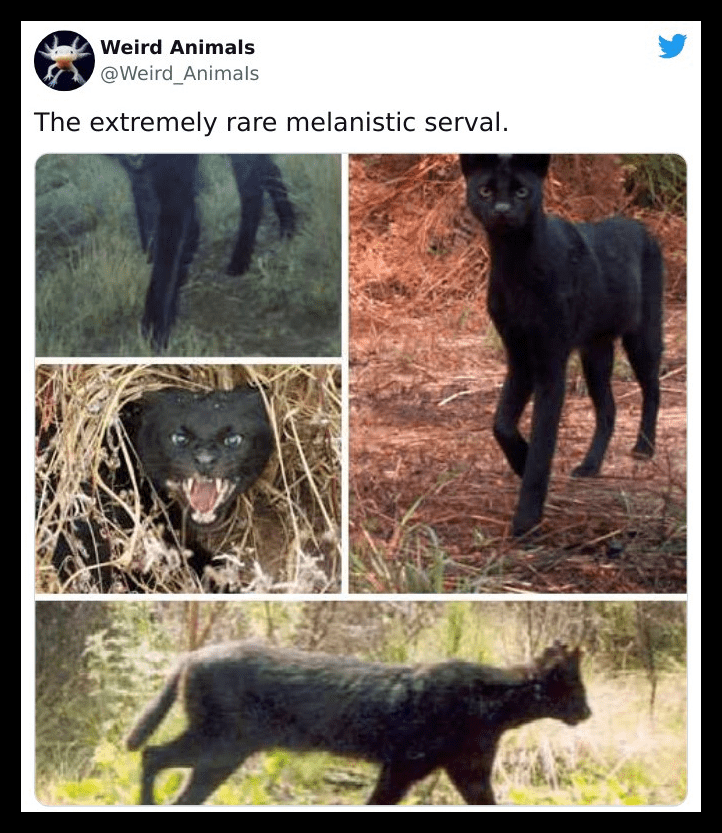
The melanistic serval technically isn’t a species of its own. Instead, it is a normal serval that was born with a genetic defect that overproduces melanin. The serval is a small predator cat that is mainly found in sub-Saharan Africa.
The Desert Lynx
The caracal, or desert lynx as it is also known, is another smaller-sized wild cat measuring around 50 cm long. The lynx lives across a wide area, from parts of Africa to the Middle East and even parts of India.
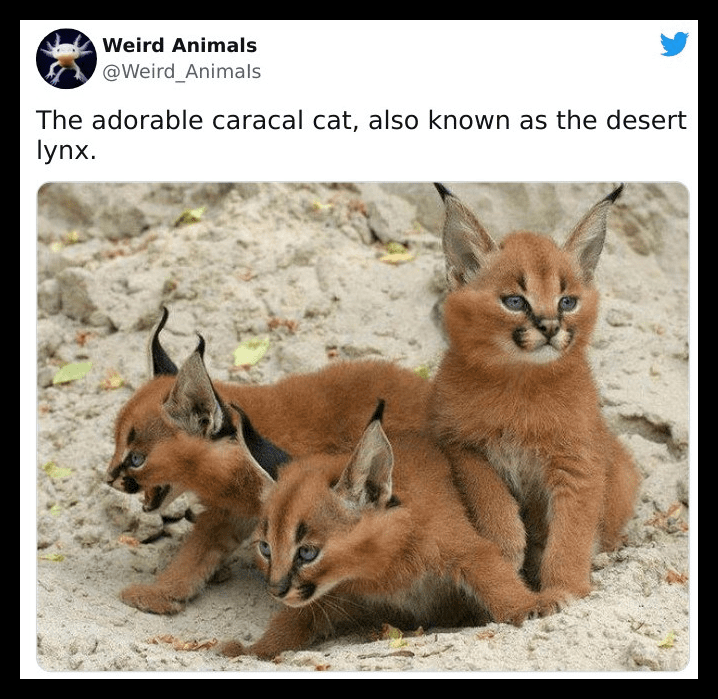
And this is what the desert lynx looks look like as a cub. Are they just not super adorable with their brownish-ginger coats and enchanting grey-blue eyes? These lynx were also culturally important to the area and were used to hunt game birds.
The Black Heron
The black heron (or egret) is a beautiful little bird that is native to large swathes of Africa. The black heron with a truly ingenuous method of hunting that you have likely never heard of before. Here’s a hint, it involves feathers.
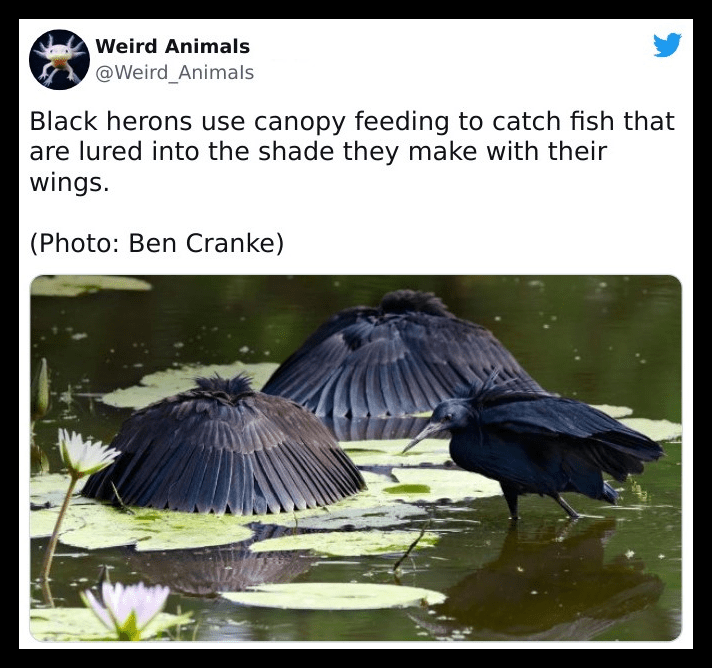
The heron feeds off of fish that it fishes from shallow lakes. What they do is they fan their wings around themselves and create a canopy of sorts. The fish are then attracted by the shadow of the canopy and are quickly snatched up!
The Pied Butterfly Bat
A lot of animals get an unfair treatment based on their appearances, like bats, as we mentioned before. This next bat, however, might change your mind. Introducing the pied butterfly bat also known as a badger bat. So, what makes it so special?
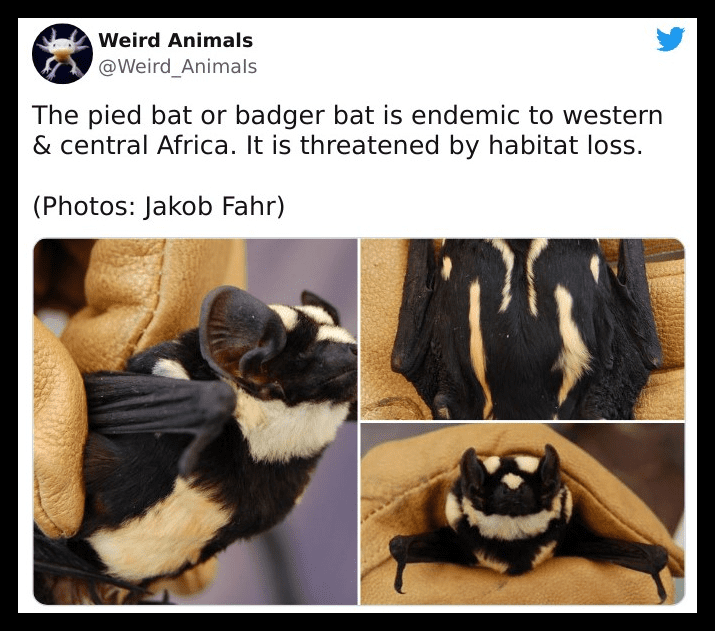
The pied bat is a rare species of vesper bats and is native to subtropical African forests. From the Congo to the Ivory Coast, you will find these colorfully striped little guys flapping amongst the treetops. Not so bad anymore, are they?
Dancing Bats
If the pied bat wasn’t able to change your mind, we have a feeling the next one might do the trick. At first, you might be really puzzled as you stare at this picture of what seems to be dancing bats.
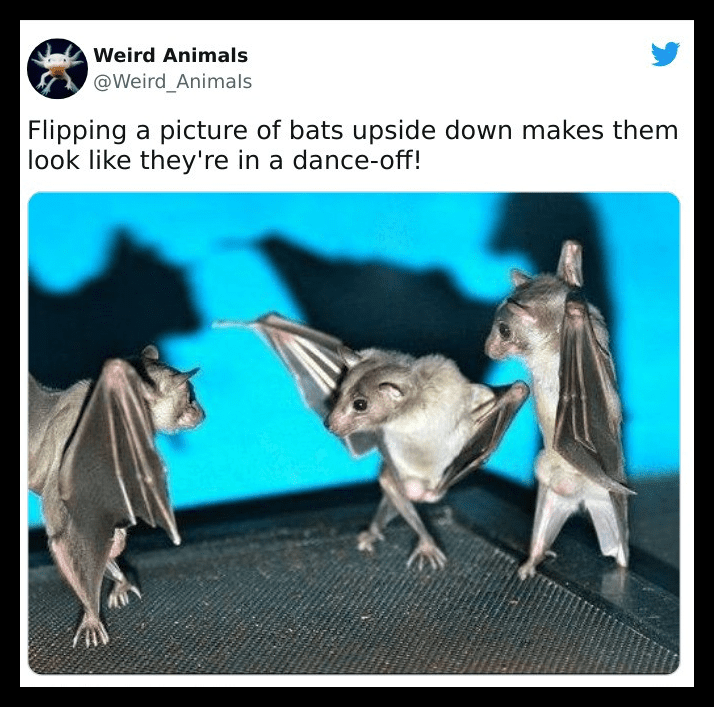
Only they aren’t really dancing. What you are looking at is some clever perspective, and the picture of the bats, perched upside-down, is itself upside-down. We wonder who had the brilliant idea of doing this! It definitely does help in making them a bit cuter.
The Paradise Tree Snake
Continuing on the theme of animals that get treated differently depending on their looks, snakes are a weird one. They either immediately invoke feelings of fear and repulsion or feelings of delight and awe. This next one, however, is objectively cool.
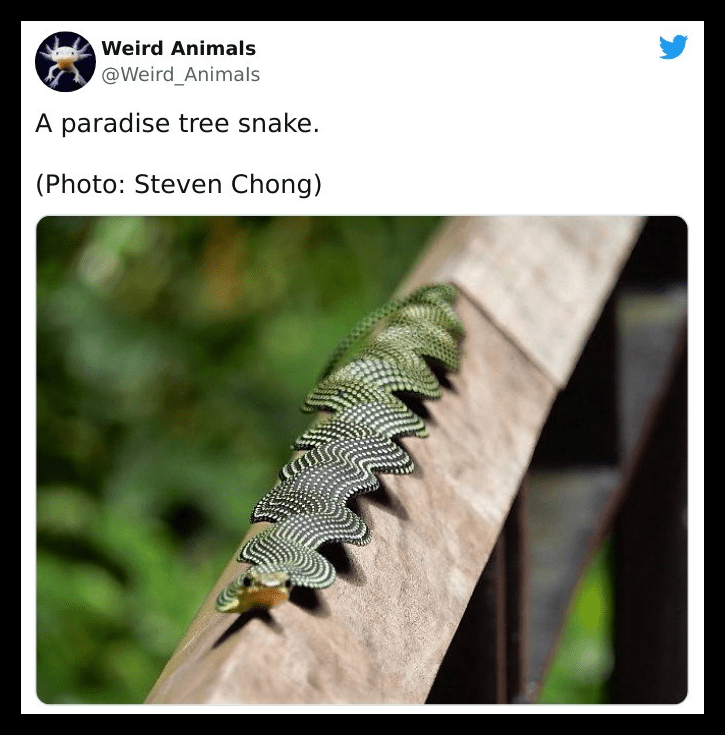
This is the paradise tree snake from South-eastern Asia. What makes this snake really amazing is its ability to jump and glide from tree to tree. They have been reported of being able to glide for 10 meters or more.
Dragon Snakes
The Xenodermus javanicus, more commonly called the Dragon snake, is another really cool and rare breed of snake. The Dragon snake gets its name from the distinctive ridged and ribbed scales that cover its body — a design that isn’t just for looks.
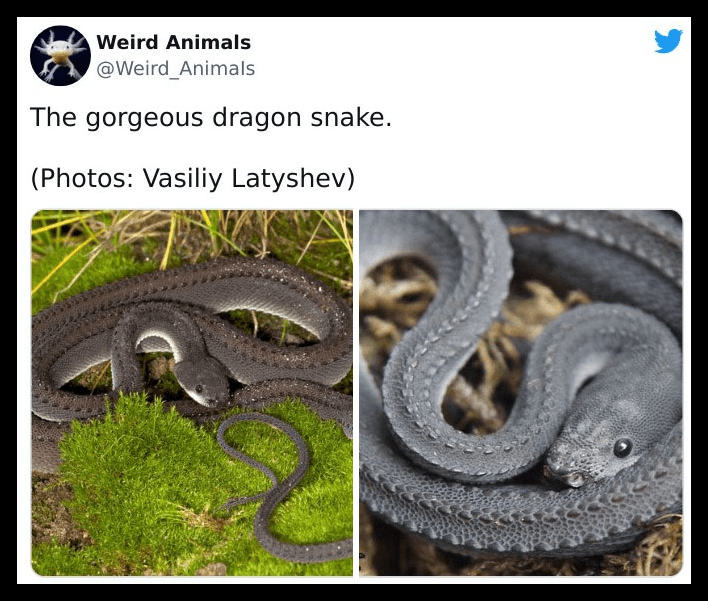
It’s believed the snake’s skin assists it as it burrows into the ground and also acts as a defense mechanism. When threatened, the snake will stiffen its entire body, which is quite weird. While they might look dangerous, they’re actually not poisonous.
The Orchid Mantis
We showed you some interesting insects earlier, but we have not shown you all of them just yet. Here we have the orchid or walking flower mantis from Southeast Asia. While the orchid mantis might seem harmless, looks can be deceiving.
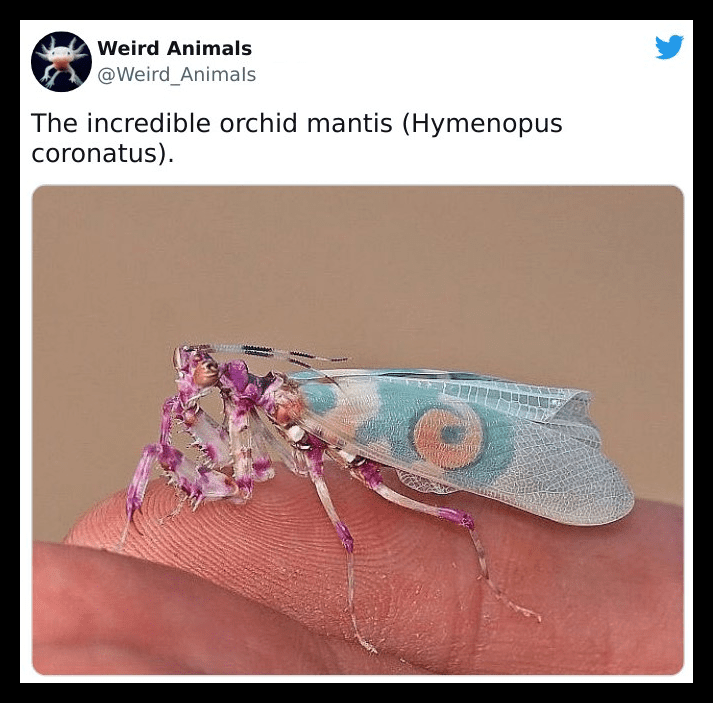
The orchid mantis is known to attack its prey at a blinding speed, inflecting quick killing blows. Its diet is mainly comprised of various species of insects and even other mantises of their own species. That’s not grim at all.
A Fruit Piercing Moth Caterpillar
Alright, this next critter is easily one of the coolest insects we have ever seen! This alien-looking and outer space-designed lump on a twig is the caterpillar form of the fruit-piercing moth. We cannot even tell where its head is.
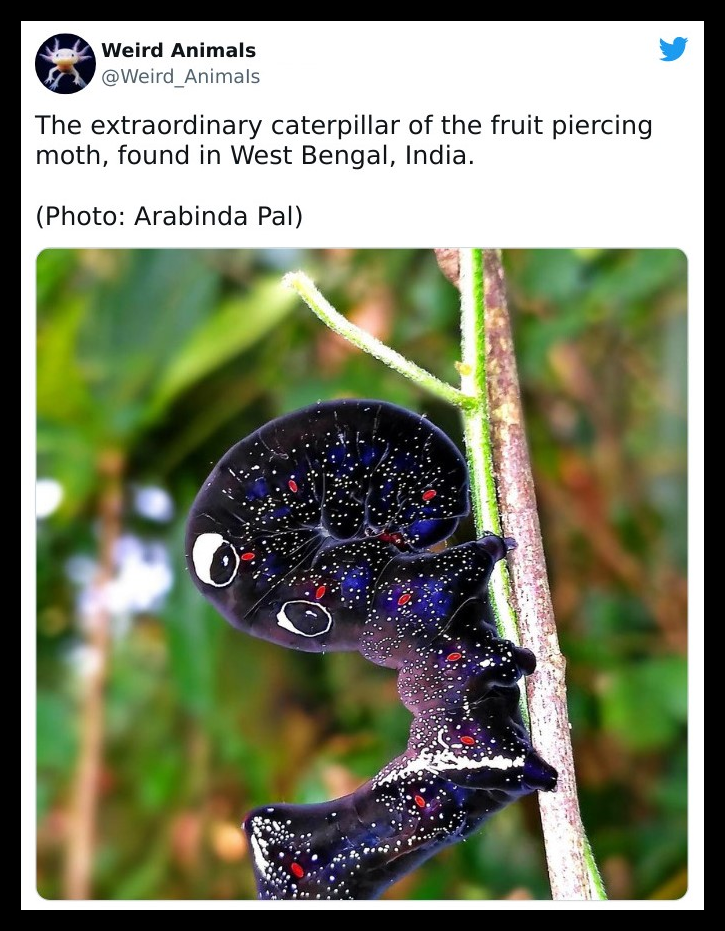
While they might be amazing to look at in their caterpillar form, they are considered an agricultural pest once grown. As their name implies, they damage fruit plantations by piercing into the fruits’ skins and draining them of any liquid.
A baby Swordfish
This tiny little thing you are looking at is actually how big a swordfish is when it is a baby. This feature is one of the two things that just make the swordfish a bizarre animal. The second is their sword-like bill.
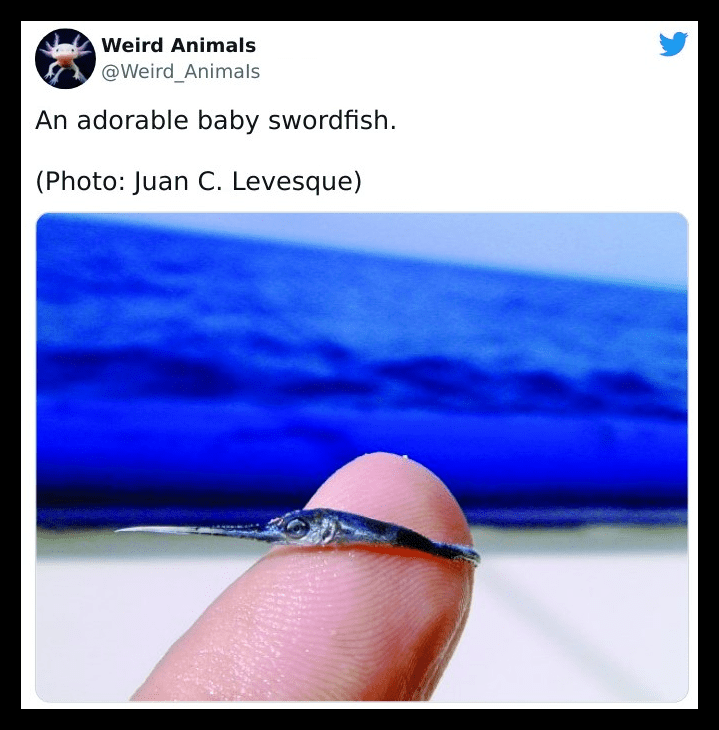
A baby swordfish is said to be only slightly larger than a grain of rice. This is quite surprising when you learn that it can grow to be anywhere between 3-4.5 meters in length. Not to mention that it will weigh 650 kg.
Liomera Rugata
It’s safe to say that quite a lot of the stranger-looking animals tend to come from the deep blue, and this crab is no exception. The Liomera rugata is a crab so magenta and fuzzy-looking, that it doesn’t seem real.
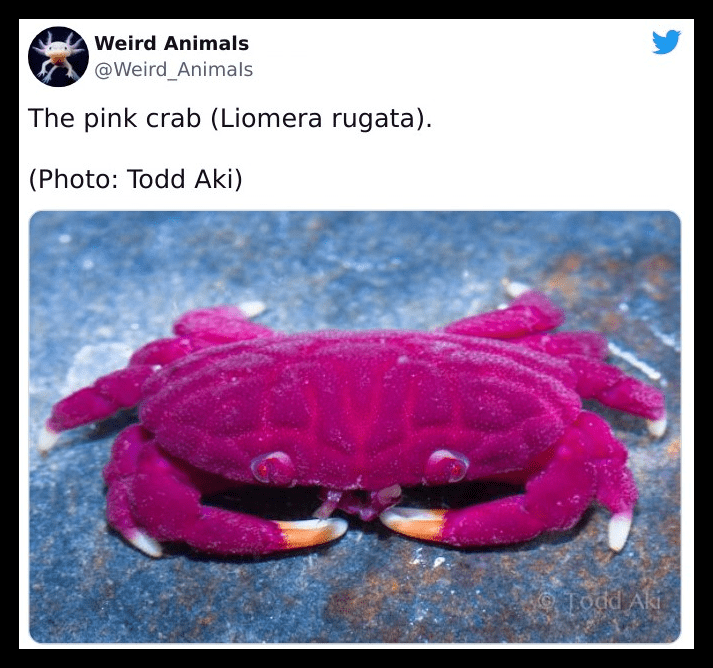
Unfortunately, we do not know all that much about these strange and quirky crabs, which is a shame. All we know is that they live in the Indo-Pacific Ocean and were discovered in 1834 by entomologist Henri Milne-Edwards. Poor little guys.
A Baby Squid Inside its Egg
Speaking of weird animals, we would imagine that very few would be stranger than squids and octopuses. Just everything about them is so odd, which is probably the reason why they have inspired so many deep-sea myths. Check out this squid.
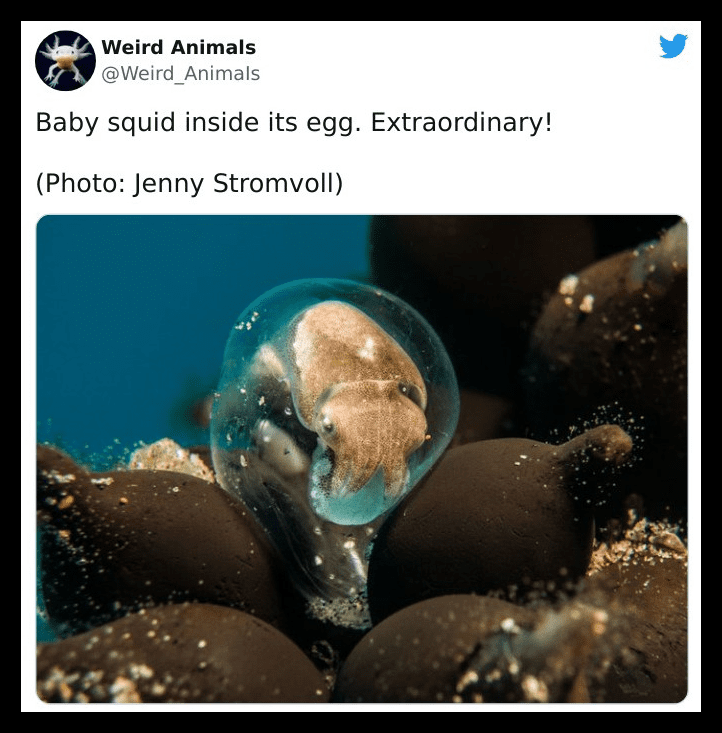
What you are looking at is an adorable baby squid that is actually still inside its egg. Yep, that jelly-like bubble is actually the egg casing. We’re not quite sure what type of squid this is, but it’s a show stealer!
Flannel Moth
This lump of fluff is actually a breed of moth called a southern flannel moth, though it goes by other names, too. We aren’t kidding; this moth has at least 10 other names, which could be confusing if they spoke human.
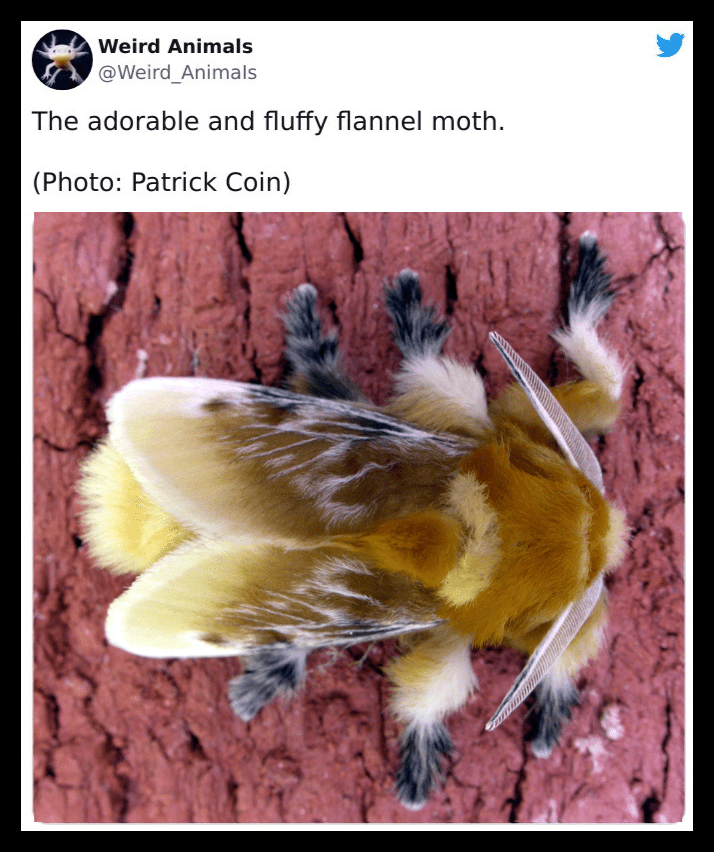
The flannel moth is known for its thick and colorful coat that many have often compared to cats’ tails. It normally lives atop trees such as elms and oaks, located in the Eastern US and Mexico all the way through Central America.
The Ruff Bird
Some birds are known for their dazzling and mesmerizing patterned and colored feathers. Others, on the other hand, are more known for their bizarre features and appearances. Not ugly, but just odd. A good example is Calidris pugnax or ruff.
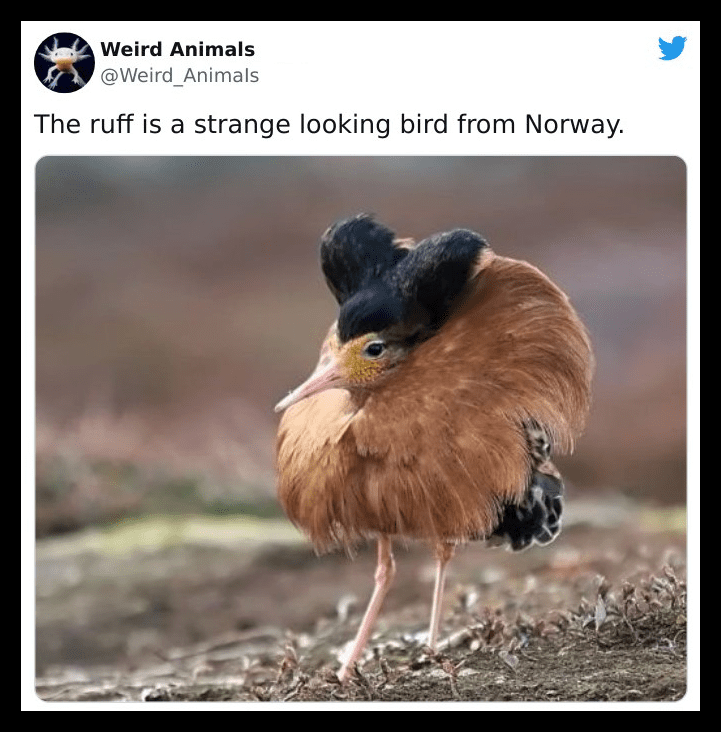
The ruff is a type of wading bird (that means it hunts in marshes and meadows) that lives throughout Eurasia. This peculiar one, in particular, is a Norwegian ruff. The ruff exclusively breeds along Scandinavia across to the northernmost parts of Russia.
Diaethria Neglecta
We hope you’re ready for another amazing butterfly to look at because we have a great one to show you. This enchanting and elegant-looking butterfly is called a Diaethria neglecta. It, unfortunately, does not have a common name as of yet.
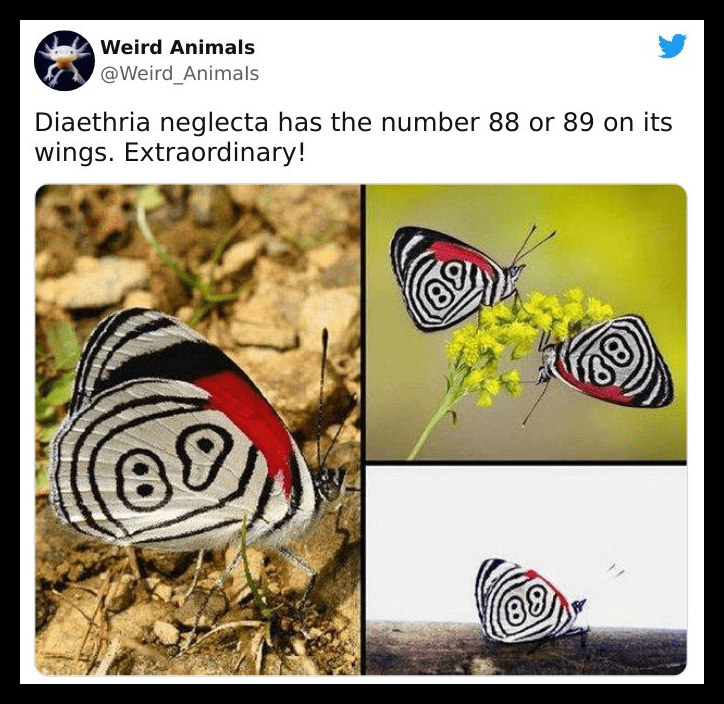
That said, the Diaethria neglecta is part of the Diaethria genus, all of whom are commonly referred to as eighty-eights. This is due to the two eight-like designs that you can see on the underside of their wings. Though it sometimes “reads” as eighty-nine.
New-born Hognose Snakes
And following the old saying, “leaving the best for last,” we have done so and saved one of the cutest images for last. These adorable orange cuties are twin hognose snakes, a name they were given due to their upward-shape snouts.
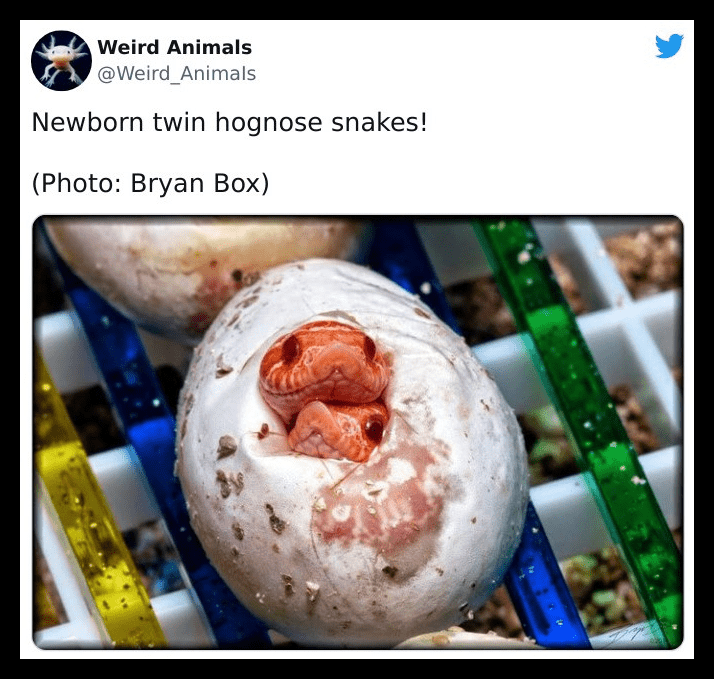
They use their oddly shaped snout to dig into sandy soils, allowing them to burrow or hunt for food. The name “Hognose” actually refers to a variety of snake species that share a similar nose structure but aren’t all related.
